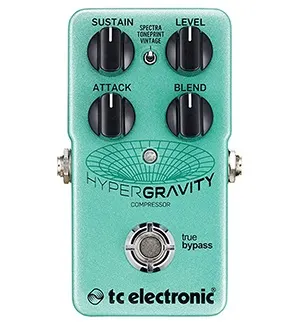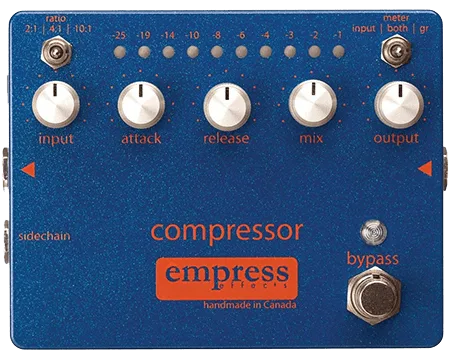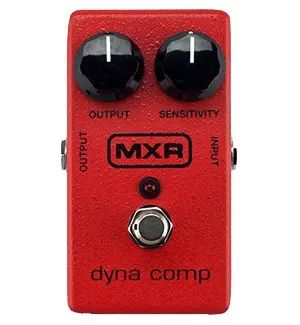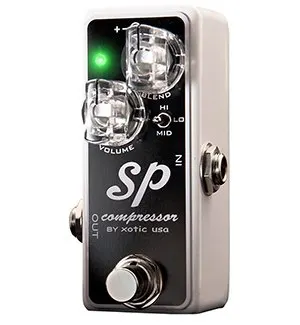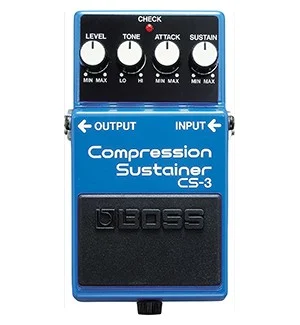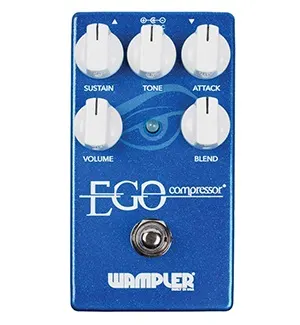The best compressor pedal polishes your tone and increases your sustain while reducing the variances in dynamics so you always cut through the mix while matching the tone of the top guitarists. In the present age of music, a compressor isn’t an option but an expectation. We’re here to help you understand which best serve your needs…
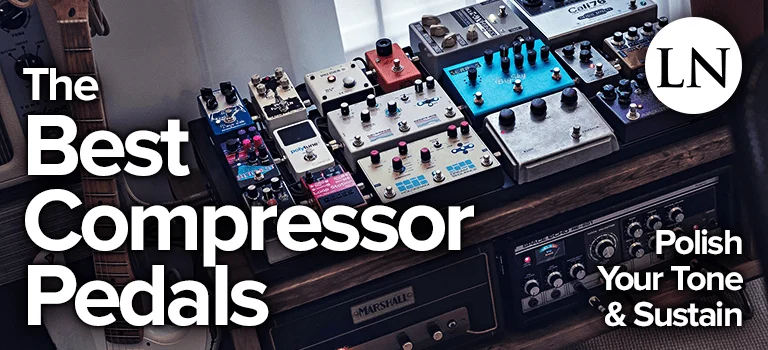
If there’s any audio effect that’s used the most and had the most impact on music, it is by far the compressor effect. It takes the lead so hard that mastering engineers are even going through “The Loudness Wars” over it. It’s influence has been monumental.
Whether you’re a guitarist, vocalist, synthesizer player, or literally anyone else involved in music, you’ll be using compression in a live setting and it’ll be applied during the mixing stages after recording. Nobody escapes it and nobody wants to.
The reason is, we went from recordings and performances that varied in volume levels so drastically that the listeners would go from not really being able to make out certain segments to others hurting their ears.
With this effect engaged, all of that variable dynamic range is reduced. We still have the pleasurable rollercoaster ride through volume levels, but they stay in a comfortable and intelligible range now.
Need more information in order to better understand your needs? We have got you covered! Visit our FAQs section.
Included in this section:
| TC ELECTRONIC HYPERGRAVITY | Best Bang for the Buck | Buy on Amazon |
| EMPRESS EFFECTS COMPRESSOR | Best of the Best | Buy on Amazon |
| MXR DYNA COMP | Best Budget Pick | Buy on Amazon |
| XOTIC SP COMPRESSOR | Most Versatile on the List | Buy on Amazon |
| BOSS CS-3 COMPRESSOR SUSTAINER | Best for Boosting Low Signals | Buy on Amazon |
| WAMPLER EGO | Most Modern Pedal | Buy on Amazon |
The Best Compressor Pedals
Now that we’ve reduced the complexity of compressor pedals, know what features to look out for, and how to use them in general, it’s time to venture out into the marketplace and see what the best options are for our hard-earned money and needs.
There’s no specific order below other than to point out our top pick. You can see our two other “best in class” picks in the table at the top of this article, but remember that if they made this list they more than met our expectations. Consider them all since your preferences may be slightly different than ours. These are the top choices out there right now.
TC ELECTRONIC HYPERGRAVITY
Our “Best Bang for the Buck” pick goes out to the TC Electronic HyperGravity for a very specific reason. Not only do you get their Vintage mode compression, which emulates our “Best Budget Pick” option, the MXR Dyna Comp (the pedal most others have modeled themselves after), you also get access to their Spectral mode.
This Spectral mode is a multiband compressor that compresses the lows, mids, and high frequencies separately using the same MD3 algorithm they developed for their System 6000 mixing and mastering suite.
The reason multiband compression is advantageous is that each band reacts to itself instead of the entire frequency spectrum. So normally if your guitar tone has a lot of bass for a particular song, the low frequencies might cause the compression to engage far earlier than they should for the mids and highs, meaning you’ll experience some tone loss and equalization imbalance. Spectral mode gets around that masterfully, with high or low sustain, since even that is split into bands.
There’s also the TonePrint technology TC Electronic is including in all their guitar pedals (as well as true bypass) where you can download professionally customized presets by famous players and store them in the third mode. You can even beam them to the pedal from your smart phone through your guitar or bass pickup. It’s pretty cool.
I also appreciate that you can control your attack independently from the threshold on this model. Many don’t provide that option. If you want access to three solid compression modes at once for a reasonable price, you’ll get no better bang for your buck than this choice.
Specs:
- Item Weight: 0.32 pounds
- Signal Format: Analog
- Voltage: 9 V
Pros:
- Versatile pedal
- Provides lively audio
- Reliable and great build quality
Cons:
- Its features can be overpowering
EMPRESS EFFECTS COMPRESSOR
There are a lot of nice compressors out there, but in my opinion the Empress Effects Compressor takes the cake. It might have an untraditional shape to it, but it more than justifies it. First of all, show me one other pedal on this list that lets you control the release parameter. Then try to find me one that has metering on it. You can’t!
Why is this nice? Because you can not only view your input amplitude on the LED meter, which helps you set up your compression levels, but you can also view the gain reduction of the compression. When you’re on stage, you can’t always use your ears to set your levels, but you can do fast visual checks.
I also like that you don’t set the threshold (or sensitivity or whatever others want to call it). You set your ratio to one of three choices with the toggle on the top left and then control your gain reduction by using the input volume knob. In addition, you can always use the mix knob to blend your result with your dry signal so you can even do a parallel compression of sorts.
You can even sidechain it to any other audio source so you can duck out of the way of the lead guitar or vocals, for instance. And you also have a makeup gain output knob.
That’s all fine and dandy but how does it sound? It as absolutely transparent. You don’t get coloration. You just get a squashed version at the output that you can then send on to reverb and delays. That’s the nice thing about compression.
It sweetens every effect that comes after it by feeding it a more dynamically controlled signal. And you’ll get no better method of doing that than this Empress Effects model.
Specs:
- Item Weight: 0.8 pounds
- Signal Format: Analog
- Voltage: 9 V
Pros:
- Great form factor
- Offers great sound quality
Cons:
- Can be too transparent for some
MXR DYNA COMP
You’re looking at our “Best Budget Pick” and perhaps the most popular guitar compressor pedal of all time, the Jim Dunlop MXR M102 Dyna Comp. You’ve heard it on more records and pop hits than you even know.
Most other compressor pedals on the market modeled their sound after this one, trying to achieve the same rich sustain and percussive picking thanks to the tad slower attack. It’s the least secret “secret weapon” out there, especially in Nashville.
If you notice there’s only two knobs: Output and Sensitivity. The Sensitivity knob reduces the threshold, increases the ratio, and adjusts the attack and release at the same time depending on the setting. At around 12 o’clock you’ll get more girth, adding thickness and a bit of sustain to your signal.
Crank it all the way to the right and you’ll get a lot more sustain and a lot of punch while still retaining your smoothness. And then you can makeup the lost gain through the output knob. The extreme values of sensitivity is where the magic happens and what made this pedal the stage and studio standard.
Just because it’s less expensive doesn’t mean anything. This is still one of the most highly regarded options available, reigning for over 30 years, often named the best compressor pedal of all time.
If you don’t want to adjust all the options individually and just want to dial in the right sound, then get this one. There are others that are similar and equally good, but there’s zero guesswork here. It’s trusted for a reason. Everyone loves its warm, colored compression.
Specs:
- Item Weight: 1.05 pounds
- Signal Format: Analog
- Voltage: 9 V
Pros:
- Easy to use and great build quality
- Great value for money
Cons:
- Adjusting the level of attack is not possible
XOTIC SP COMPRESSOR
Among the easy to use options, the Xotic SP Compressor is another that is all the rage. But it’s only simple on the surface, with a set of four dip switches packed within the chassis. Though this one has only two knobs, they aren’t the ones you’re used to seeing.
Instead of having a sustain knob, you’re looking at a Blend (wet/dry mixing) and an input Volume knob to increase or decrease the amount of the effect. It starts to get impressive when you notice the Hi / Mid / Lo sustain and compression switch, where you can set the ratio of compression.
But the real magic begins when you start using the dip switches. Various combinations of those provide all kinds of “presets” for lack of a better term and are all explained in the user manual with picture guides. Among the controls in there are attack and release times, high cut filter, input pad, and more.
They guide you through setting it up, showing you how to get the sound of a single coil in a classic vintage style or country twang. You can get a humbucker pickup sound that’s “sparkle clean” or even use it as a boost with a subtle amount of compression.
Compared to a classic like the MXR Dyna Comp above, this one is far more transparent with a lot more hidden options. For the most part you’ll set the dip switches to what suits you and leave them there, and then get the rest of the changes you want out of the ratio toggle and the blend knob.
But it’s nice to have the dip switch choices, where you can customize a great pedal to what you want then hide those options away, versus having to settle for what a company created for you, even if it is highly regarded. Choices are good and so is simplicity. You get both here coupled with incredible quality.
Specs:
- Item Weight: 0.85 pounds
- Signal Format: Analog
- Voltage: 9 V
Pros:
- Good build quality and easy to use
- Great value for the money
- Versatile and offers excellent sound
Cons:
- Clear knobs featuring black stripes can be hard to read
BOSS CS-3 COMPRESSOR SUSTAINER
Boss always comes correct and it’s no different with their Boss CS-3 Compressor Sustainer. The most interesting fact about this model is that it doesn’t just reduce the volume of peaks that go over the threshold, it also acts as an expander and blooms out the quiet parts too, leading to a much smoother overall sound.
With such a low noise floor you can expand the quiet parts and boost the output volume and still experience a nearly noiseless operation. Combine it with a noise gate pedal and you will have a completely noiseless signal.
Boss also didn’t skimp out on tonal shaping. I always prefer compressors where I can control everything, and this has that. Not only can you shape the attack and set the sustain levels, but you even get a Tone knob. This is great for when you don’t want to lug around extra pedals like an EQ or simply don’t own one. In this case it’s not a full blown EQ but a frequency range selector for what will be compressed or not.
These extras are always welcomed, like being able to use a battery or an AC adaptor for the power supply (many others have this too), having a nearly indestructible metal casing, and having a huge foot switch you can’t miss. Everyone knows and loves Boss for a reason. You simply can’t go wrong with them.
Specs:
- Item Weight: 1.06 pounds
- Signal Format: Analog
- Voltage: 9 V
Pros:
- Durable and excellent compression quality
- Great price for the performance
Cons:
- Slightly adds color to your sound
WAMPLER EGO
There was no way the Wampler Ego wouldn’t make this list. You’re looking at nearly as many options as our top pick in a standard sized pedal. This is a modern option, not trying to mimic a vintage pedal that colors your signal. It’s completely transparent while still offering every signal processing choice available in a compressor, all with having soft relay switching and true bypass, hand built in the USA.
Here, you get a Sustain knob to boost the volumes under the threshold to increase the tails of your notes as well as a traditional style Tone knob that acts as a high roll-off EQ. You can use the Blend knob to mix the wet and dry signals (a must if you ask me to maintain some dynamics but increase intelligibility), and of course the Volume knob to drive the input and control the amount of compression.
You also get to control the attack so you can still hear the picking of the strings or squash that too. The choices are yours with this many parameters to tweak.
From chickin’ pickin’ with plucky attacks to a hint of girth, all the way to a highly squashed metal guitar or bass sound, the Wampler can do it all. You can start with some of the suggested settings you get in their manual and tweak from there, or experiment till satisfied. But in the end, that is what you’ll be with this bad boy… satisfied.
Specs:
- Item Weight: 0.75 pounds
- Signal Format: Analog
- Voltage: 9 V
Pros:
- Offers versatile tones and incredibly transparent
- Solid build quality and easy to operate
Cons:
- Takes time to adjust it to your sound
FAQs
In this section, let’s take a look at exactly how it works, how to use it, and what to look for when you purchase one. By the time we’re done, you’ll know exactly how to choose the most appropriate one for your needs.
What is the Compressor Effect?
The compressor effect provides a means by which you can control the variance in amplitude of a sound or series of sounds. This is done by forcing the highest volume parts of a sound to be quieter so that the gap between the peaks and lowest volume parts is reduced. The lesser volume difference adds intelligibility to a sound, making it easier for listeners to interpret and ‘latch on’ to it.
This is achieved by setting a threshold level of decibels, and when the sound rises above that level it is then reduced by a specified ratio. For instance, if you set the threshold at 50 dB with a ratio of 3:1 and the sound rises to 59 dB, the compressor will ensure that only 53 dB is outputted.
The reason is because the sound went over the threshold by 9 dB, and it is reduced by a three-to-one ratio, so for every 3 dB that went over the threshold only 1 dB is allowed through.
There are also two other settings, called attack and release, that control how soon the effect begins taking place after the sound crosses the threshold and when it stops acting upon the sound after it dips below the threshold again.
The attack is used to shape the attack of the pick, where you can squash it or allow it to ring through. The release can sound unmusical if set too fast and unnatural if set too slow.
What to Look for in the Best Compressor Pedal?
At this point, all compressors are about the same in terms of quality. They all perform the same signal processing task that hasn’t changed or had a reason to change since its invention. But with that being said, there are two considerations to keep in mind.
The first is to not purchase too cheaply. While the outputted sound quality might be extremely similar between inexpensive and high-end compressor stomp boxes, the cheap ones can be too slow in their reaction to handle very fast attack and release settings on complex waveforms.
You don’t want to spring for the cheapest option because you need that consistency and reliability when shaping your tone.
The other thing to consider is how finicky you want to get with the settings. Not all of these pedals have the same options. Some work more based on presets with variables you can tweak with knobs, while others give you full control. Once you understand how it all works you’ll have no problem, but some people fail to ever grasp how it functions.
Nano sized pedals might feature far less options in their mini size than a standard sized pedal. Many of the knobs do the same things with different labels. You’ll see stuff like sensitivity, output, level, sustain, clipping, and even just ‘comp.’
They all in some way relate to the four basic variables of compression, if not individually than in combination. Why they do this, I don’t know, but you’ll want to decide how much control you want over the effect or if you want to trust the manufacturer’s pre-made choices. You’ll be okay, either way, for the most part.
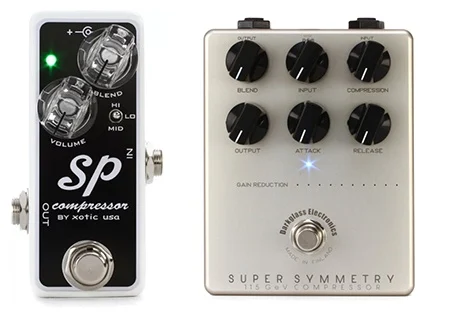
How to Use a Compressor Pedal
Despite our conversation about how complex compressors are for newcomers, the manufacturers of the pedals have opted to remove all of those choices and keep it simple. But that adds another layer of complexity. Let me explain how it all works as well as where you should place the compressor in your signal path.
Where to Place it in the Signal Chain
There’s a very specific order that all of your different pedal types should come in, and although there might be a little flexibility within sub-groups, there’s no question about where compressors should come in. Let me show you the typical pedal chain:
- Dynamics, Filters, & Pitch Shifters
- Boost & Distortion
- Modulation
- Time
Compression is a way to control the dynamics of your volume. There is only one pedal that should definitely come before it and that’s the noise gate. There is one pedal that I argue should come before compression, although it can come right after in regards to guitar, and that’s equalization.
But the main point is the compressor comes at the very start so you shape your waveform before you begin applying the rest of your effects. If you do it after, you’ll ruin the other effects by squishing your reverb and delay or defeating the purpose of a tremolo.
Understanding the Knob Settings
Let’s start with the main knob, Comp. Despite compression being made up of four independent variables, pedal makers are now creating a “proper” preset that works for nearly all guitar playing styles.
This is great, in my opinion, because nobody has time to deal with that while live on stage. And you accidentally kick your knobs, there’s no catastrophe.
You just set one knob back where you had it instead of four. This Comp knob simply raises and lowers the threshold so you can apply more or less compression. Sometimes you’ll see this being called Sensitivity or Sustain.
Other manufacturers have decided to at least give the guitarist control over the Attack of the compressor so you can decide if you want to squish the initial peak of when you pick the string or let it ring through.
The Attack knob lets you set a time in milliseconds for how long the compressor waits to kick in once a sound crosses the threshold. A slower setting lets the string’s ‘attack’ come through uncompressed.
Finally, you have a Level knob that lets you control the output volume, and some even have an EQ or Tone knob if you don’t want to have an extra equalizer pedal.
